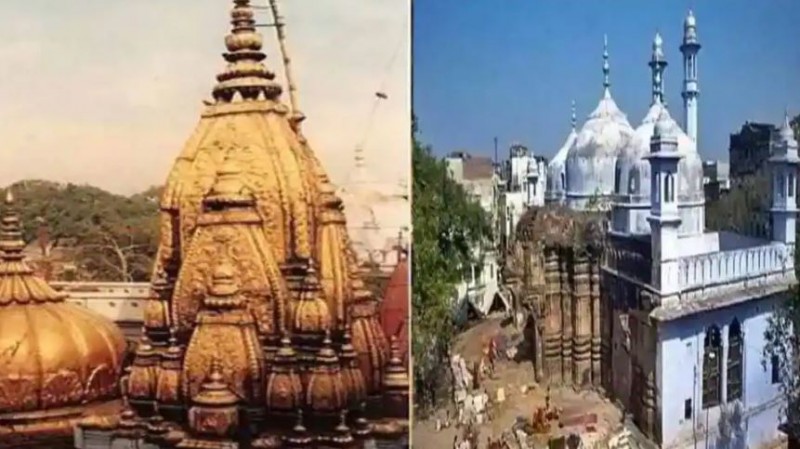
Varanasi: The Vishwanath Temple, also known as the Golden Temple, has been a symbol of religious harmony in Varanasi, the city revered for its cultural and spiritual significance. Dedicated to Lord Shiva, this temple has long attracted pilgrims and devotees of different religions, promoting an atmosphere of coexistence and shared spirituality. Historical accounts show that the Vishwanath temple first faced destruction during the time of Qutubuddin Aibak, the first Sultan of Delhi and founder of the slave dynasty. In 1194 AD, Aibak defeated the ruler Jayachandra in the battle of Asni and captured the city of Banaras (Varanasi). After this, the Vishwanath temple fell victim to this victory and was demolished.
Aurangzeb's reign and construction of the mosque:
During the reign of the sixth Mughal emperor Aurangzeb, the Vishwanath temple suffered another round of destruction. Aurangzeb was known for his conservative and rigid interpretation of Islam, which led to several actions against Hindu temples and religious practices. It is documented that the Vishwanath temple was one of the targets of his religiously motivated policies. A mosque was constructed at that place in place of the temple.
Evidence in historical records:-
Dr. Motichandra, who wrote 'History of Kashi,' supported the demolition of the Vishwanath temple during the reign of Aurangzeb and highlighted this in detail. His book 'History of Kashi' sheds light on the events that took place during that time, including the destruction of the temple and the subsequent construction of the mosque. Additionally, the book 'Kashi, Nagri Ek: Roop Anek,' edited by Om Prakash Kejriwal, reinforces the claim of the demolition of the temple during the reign of Qutubuddin Aibak, providing historical recognition. Kejriwal's book has a relevant quote from the Persian book 'Taj-ul-M'Asir' written by Hasan Nizami – "From there (Asni), the imperial army left for Benaras, which is the center of Hindustan. Here, the army demolished about a thousand temples and built mosques in their place. Due to this, many temples were converted into mosques, or mosques were built with the material of temples. For example, the two-and-a-half-kangure mosque leading to Hanuman Phatak from Daranagar, the lower part of which is made up of Hindu temples. The northern and western parts of Makdoom Sahib's graveyard in Gulzar Mohalla were also built with the material obtained by demolishing the temples. Similarly, the mosque of Bhadon Mohalla was also made of temple material. The hallway of a mosque in the area of Rajghat is made of pillars from the Gahadwal era. Motichandra has listed many such examples in his book when temples were demolished during the Sultanate period, and mosques were built with the help of their material. According to Dr. Motichandra's historical account, both Vishwanath Temple and Gyanvapi Mosque suffered demolition during their turbulent past. The mosque builders not only demolished the western wall of the old temple but also demolished the smaller temples. Additionally, they closed the western, northern, and southern gates, removed the spire, and built domes in their place. The sanctum sanctorum of the original temple underwent a change and became the main hall of the newly built mosque. While four interior houses were preserved, the hall was demolished and integrated into the pavilion in a 24-foot amalgamation. Furthermore, the eastern side of the temple was demolished, and a verandah was built in its place, which is still equipped with ancient pillars. The eastern pavilion, which was earlier 125 x 35 feet, was transformed into a long square by adding stone squares. Dr. Motichandra's detailed historical records shed light on the extensive changes and adaptations that took place during this period of religious and architectural change.
The ongoing debates and disputes surrounding the Gyanvapi complex, which houses the Vishwanath Temple and the Gyanvapi Mosque, highlight the complex nature of historical narratives and religious sentiments. The Hindu side claims that the mosque was built by demolishing the ancient Vishwanath Temple, while Muslim organizations contend that it is and should remain a mosque, invoking the Indian Constitution and the law to support their stance. In such contentious situations, it is crucial for all parties involved to approach the issue with sensitivity, empathy, and respect for one another's beliefs. Preserving historical sites and their stories is essential for understanding the diverse and rich cultural tapestry of India. It is also essential to find ways to honor and respect the historical significance of these places while promoting peace and harmony among different religious communities.
The Vishwanath temple in Varanasi has had a tumultuous past, with demolition and reconstruction at different periods of history. The details of its destruction during the reigns of Qutbuddin Aibak and Aurangzeb have been attested by historical records and contemporary surveys. However, despite these examples, the temple stands as a symbol of resilience and religious harmony, attracting people from all walks of life to seek solace and spirituality in its sacred premises. It is essential to preserve and understand the history of such sites to appreciate the diverse tapestry of India's cultural and religious heritage. the Vishwanath Temple in Varanasi is not just a religious monument but a living testament to India's history and the complexities of its cultural and religious heritage. While it has faced destruction and reconstruction throughout its past, it continues to inspire people with its message of religious harmony and coexistence. To ensure that such sites continue to thrive as symbols of unity, it is vital for all stakeholders to engage in constructive dialogue and work towards preserving India's diverse cultural legacy for generations to come.
The Spiritual Significance of Offering a Three-Leaf Belpatra to Lord Mahadev
Fulfill Your Wishes by Chanting Lord Shiva's 108 Names in this Auspicious Month
Khesari Lal Yadav's devotional song released in Sawan said to Bhole Nath, 'Utha Bhole Dani'